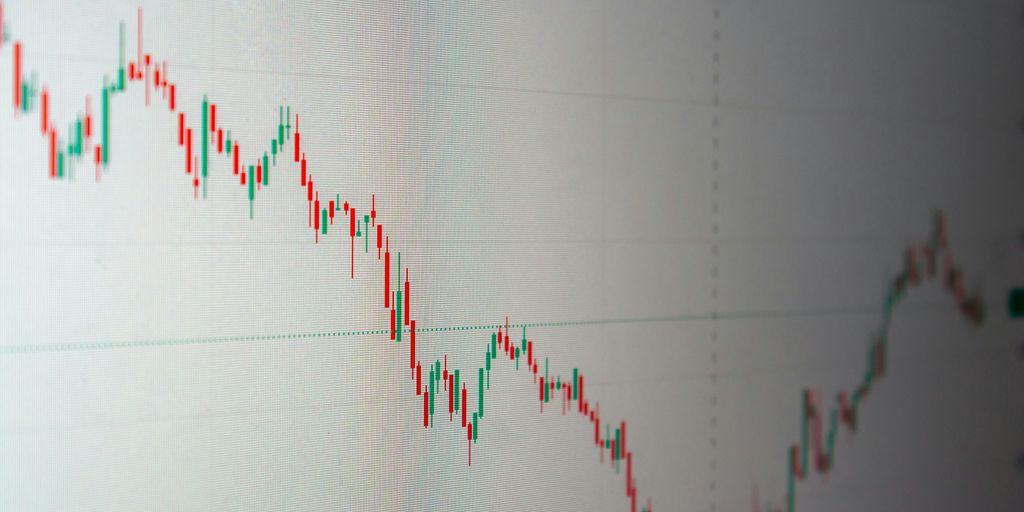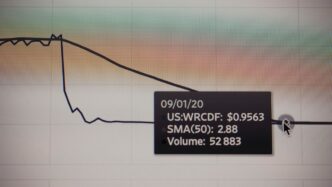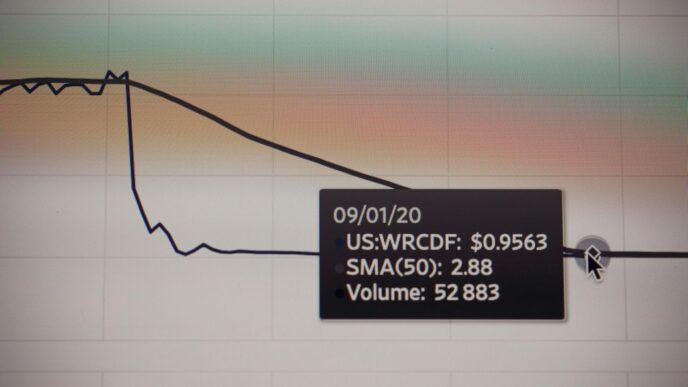So, the crypto market is doing its usual thing, right? Prices are going down, and everyone’s either freaking out or trying to act cool. But what if this whole “crypto dropping” situation isn’t just a bad thing? What if it’s actually a chance to get in on some good deals? We’re going to talk about why these dips might be a good thing for your wallet and how to spot those chances.
Key Takeaways
- Crypto price drops, or “dips,” are pretty normal, not always a disaster.
- These dips can be a good chance to buy crypto at a lower price.
- Look for big price drops and signs of things getting stable before you buy.
- Think about buying small amounts over time to avoid big risks.
- Always do your homework and don’t let feelings make you buy or sell.
Understanding the Crypto Dropping Phenomenon
Defining a Crypto Dip
Okay, so what is a crypto dip? Basically, it’s when the price of a cryptocurrency goes down significantly. Think of it like a sale on your favorite item, but instead of clothes, it’s digital currency. It can be a small, short-term drop, or it can be a longer, more serious downturn. Dips are a normal part of the crypto market cycle.
Factors Contributing to Price Declines
Lots of things can cause crypto prices to drop. It’s not always one single reason, but usually a combination of factors:
- Market Sentiment: If people are scared or uncertain, they sell, and that drives the price down. Negative news, rumors, or just general fear can all contribute. It’s like a snowball effect.
- Profit-Taking: When the price of a crypto goes up a lot, some people will sell to take their profits. This selling pressure can cause a dip. Makes sense, right?
- Broader Economic Factors: What’s happening in the overall economy can affect crypto too. Things like changes in regulations, global economic trends, or even downturns in the stock market can all play a role.
- Technical Corrections: Sometimes, after a big price jump, the market just needs to cool off. This is called a "correction," and it’s when prices fall back to a more sustainable level.
The Volatile Nature of the Crypto Market
Let’s be real, the crypto market is known for being volatile. Prices can go up and down a lot, and quickly. This volatility is just part of the game. It doesn’t necessarily mean the end of the world (or the end of a particular crypto) when you see a dip. It’s important to remember that dips are a pretty normal part of the crypto market’s volatile nature.
Why a Crypto Dropping Trend Can Be an Opportunity

Reframing Dips as Potential Gains
Okay, so the market’s down. Everyone’s panicking, right? But what if we looked at it differently? Instead of seeing red and running for the hills, think of it as a sale. A chance to snag some crypto at a discount. It’s like your favorite store having a clearance event – you wouldn’t avoid it, would you? This is where the smart money starts to move, accumulating assets while others are fearful. It’s all about perspective.
The Power of Long-Term Vision
Crypto isn’t a get-rich-quick scheme, despite what some influencers might say. It’s more like planting a tree. You don’t expect to see a forest overnight. You need to have a long-term vision. Are you in it for the tech? The potential? The future of finance? If so, then short-term dips shouldn’t scare you. They should be seen as opportunities to increase your holdings before the Bitcoin reversal everyone’s waiting for. Think years, not days.
Embracing Volatility as a Strategic Advantage
Volatility is part of the crypto game. It’s like the weather – sometimes it’s sunny, sometimes it storms. You can’t control it, but you can prepare for it. Instead of fearing the ups and downs, learn to use them to your advantage. Buy low, sell high – it’s a simple concept, but it requires a strong stomach and a clear head. Here’s a simple breakdown:
- Understand the Risk: Know what you’re getting into.
- Stay Informed: Keep up with market trends and news.
- Have a Plan: Don’t just react, anticipate.
Key Indicators for Identifying Buying Opportunities When Crypto Dropping
Analyzing Significant Price Drops
When a crypto asset experiences a big price drop, it might seem scary, but it can actually signal a potential buying opportunity. However, it’s important to figure out why the price is dropping. Is it just a market correction, or is there something fundamentally wrong with the project? A significant drop from a recent peak may indicate a buying opportunity, but it is critical to identify the causes of the decline. If the reason is temporary, like a bit of bad news that doesn’t affect the long-term value, it could be a good time to buy.
Identifying Support Levels and Stability Signals
Support levels are price points where a crypto has historically found buying interest and bounced back up. Think of it as a floor. When the price drops to a support level, it suggests that buyers are stepping in, preventing further decline. Spotting these levels can help you time your entry. Also, keep an eye out for signs that the selling pressure is easing. This could be the price moving sideways or a decrease in trading volume during the downtrend. These stability signals can indicate that the dip might be ending.
Leveraging Technical Indicators Like RSI
Technical indicators can provide additional clues about when to buy. One popular indicator is the Relative Strength Index (RSI). The RSI measures the speed and change of price movements. It ranges from 0 to 100. An RSI below 30 usually suggests that an asset is oversold and could be due for a bounce. An asset may be due for a bounce when oversold conditions are detected with the aid of this technical indicator. However, it’s important not to rely solely on the RSI. It’s best to use it in combination with other indicators and your own research. For example, you could also look at moving averages or Fibonacci retracement levels to get a more complete picture. Remember to monitor world coin values to make informed decisions.
Professional Strategies for Navigating a Crypto Dropping Market
Implementing Dollar-Cost Averaging
Dollar-Cost Averaging (DCA) is a simple, yet effective strategy. Instead of trying to time the market, you invest a fixed amount of money at regular intervals, regardless of the price. This helps reduce the impact of volatility because you buy more when prices are low and less when prices are high. Over time, this can lower your average cost per coin. It’s like setting your investments on autopilot. For example, instead of trying to guess when Bitcoin will bottom out, you could invest $100 every week. This way, you’re not as affected by short-term price swings. It’s a great way to reduce volatility impact.
Focusing on Robust Foundational Cryptos
When the market dips, it’s tempting to chase after the latest meme coin. However, professionals often concentrate on cryptos with solid foundations. Look for projects with strong underlying technology, a clear use case, a capable development team, and a growing user base. These are the assets that are more likely to bounce back after a downturn. Think of it as investing in quality over hype. For instance, instead of buying a coin just because it’s trending, research its technology and team. If it has a distinct use case, it’s more likely to survive.
Utilizing Staggered Buying and Pre-Planned Orders
Don’t put all your eggs in one basket. Staggered buying involves breaking up your investment into smaller chunks and buying at different price levels. This way, you can take advantage of further dips without running out of funds. Pre-planned orders are also a great tool. Set buy orders at specific price levels that you find appealing. This allows you to automate your buying and avoid emotional decisions. It’s like having a shopping list ready for when the sales start. For example, you might set buy orders for Ethereum at $1,500, $1,400, and $1,300. This way, you’re prepared for different crypto prices.
The Meaning of Investing When Crypto Dropping
Acquiring Digital Ownership
When you buy crypto, you’re not just throwing money at some internet fad. You’re actually acquiring digital ownership. It’s like buying a piece of the internet itself. Instead of owning a physical thing, you own a piece of code on a blockchain. This code represents your ownership of a certain amount of that cryptocurrency. It’s stored in a digital wallet, and only you have the keys to access it. This is different from traditional assets, where a bank or government keeps track of who owns what. With crypto, you’re in control (as long as you don’t lose your private keys!).
Participating in Decentralized Networks
Buying crypto isn’t just about owning something; it’s about participating in something bigger. Many cryptocurrencies power decentralized networks, also known as dApps. Think of it like this: you’re not just buying a share in a company; you’re becoming a member of a community that’s building something new. By owning the local currency of these networks, you can often interact with the applications, vote on proposals, and even earn rewards for contributing to the network. It’s a way to be part of a new kind of internet, one that’s more open, transparent, and community-driven.
Considering Crypto as a Store of Value
Some people see crypto as a store of value, like gold. The idea is that, over time, the value of certain cryptocurrencies will increase, making them a good investment for the long term. This is especially true for cryptocurrencies with limited supplies, like Bitcoin. The scarcity of these assets, combined with increasing demand, could drive up their prices over time. Of course, there’s no guarantee that this will happen, and the crypto market can be very volatile. But for some investors, the potential for long-term gains makes crypto an attractive option as a store of value. It’s like betting on the future of digital finance.
Cultivating a Resilient Investor Mindset During Crypto Dropping
Prioritizing In-Depth Research and Conviction
It’s easy to get spooked when you see your portfolio value plummet. That’s why doing your homework is so important. I mean really understanding the tech, the team, and the potential use cases of the altcoins to watch this summer you’re investing in. If you’ve done that, you’re less likely to panic sell when things get rough. It’s about having conviction in your long-term vision, not just chasing short-term gains.
Maintaining Composure and Rationality
Easier said than done, right? But seriously, try to keep your emotions in check. Crypto is volatile, and big swings are normal. Don’t let fear or greed drive your decisions. Stick to your plan, and don’t make impulsive moves based on what you see on Twitter or Reddit. Take a break from the charts if you need to. Go for a walk. Talk to a friend. Just don’t make any rash decisions you’ll regret later.
Avoiding Emotional Buying and FOMO
FOMO (Fear Of Missing Out) is a killer in the crypto world. Seeing other people make money can be tempting, but chasing pumps is a recipe for disaster. Remember, there will always be another opportunity. Don’t jump into a trade just because everyone else is doing it. And definitely don’t invest more than you can afford to lose. A well-thought-out strategy beats emotional buying every time. It’s better to miss out on a small gain than to lose big by automated trading and investment platform chasing a fad.
When to Exercise Caution During a Crypto Dropping Trend
While the idea of buying low is appealing, it’s important to remember that crypto drops can sometimes signal deeper problems. Knowing when to hold back is just as important as knowing when to jump in. It’s all about being smart and protecting your investments.
Recognizing That the Bottom Might Not Be In
One of the biggest mistakes you can make is assuming a dip has hit its lowest point. Crypto crashes often happen in waves. What looks like a bargain today could be even cheaper tomorrow. Remember the 2022 crash? Bitcoin seemed to stabilize around $30,000, but it kept falling, eventually hitting nearly $16,000. It’s better to wait for clear signs of a real recovery than to try and catch a falling knife.
Assessing Uncertain Economic Conditions
Crypto doesn’t exist in a bubble. Global economic factors play a big role in crypto prices. If inflation is high, or interest rates keep climbing, people might pull their money out of riskier assets, including crypto. Before you buy, ask yourself:
- Will central banks keep raising rates?
- Is a recession coming?
- Are more crypto companies at risk of failing?
If the answers to these questions are unclear, it might be best to wait and see what happens. It’s all about protecting your capital in uncertain times.
Prioritizing Capital Preservation
Sometimes, the smartest thing you can do is nothing at all. Holding onto stablecoins or even good old-fashioned cash during a downturn gives you options. It lets you buy later if things improve, and it protects you from even bigger losses if they don’t. Waiting isn’t a sign of weakness; it’s a sign of discipline. And in a volatile market like crypto, discipline is key. Think of it this way: it’s better to miss a potential gain than to suffer a significant loss. Consider acquiring digital ownership later, when the market is more stable.
Conclusion
So, what’s the takeaway here? Well, crypto can be a wild ride, and those price drops, or "dips," are just part of the game. They can feel scary, sure, but for some folks, they’re actually a chance to pick up assets at a lower price. It’s not about guessing the exact bottom, because nobody can do that. Instead, it’s about doing your homework, understanding what you’re buying, and having a plan. Don’t just jump in because everyone else is talking about it. Think about your own goals and how much risk you’re okay with. If you’re smart about it, these dips might just turn into good opportunities down the road.
Frequently Asked Questions
What does ‘crypto dip’ mean?
A crypto dip means the price of a digital currency goes down a lot. It’s like when something is on sale. These drops can be small, quick changes or bigger, longer-lasting falls.
Why do crypto prices drop?
Many things can make crypto prices drop. Sometimes, bad news or fear makes people sell, which lowers prices. Also, after prices go up a lot, some people sell to take their profits. Big economic changes or new rules can also affect the crypto market.
How can a crypto dip be a good chance to buy?
Buying during a dip can be smart because you get more for your money. If you believe the crypto will be worth more later, buying it cheap now can lead to bigger gains. It’s like buying a popular toy when it’s on sale.
How do I know when to buy during a dip?
It’s hard to know the exact best time to buy. But you can look for big price drops, see if the price stops falling and starts to steady, or check if there’s good news about the crypto. Tools like the Relative Strength Index (RSI) can also show if a crypto might be oversold, meaning it’s due for a bounce back.
What are some smart ways to buy during a crypto dip?
Smart investors often use a strategy called Dollar-Cost Averaging (DCA), where they buy a fixed amount regularly, no matter the price. They also focus on strong cryptos that have good technology and real uses. Some set up automatic buy orders at certain low prices or buy in small amounts over time.
When should I be careful about buying during a crypto dip?
You should be careful if the market is still very shaky, or if the economy is looking bad. Don’t buy just because everyone else is, and always make sure you don’t spend more than you can afford to lose. Sometimes, waiting and keeping your money safe is the best move.














